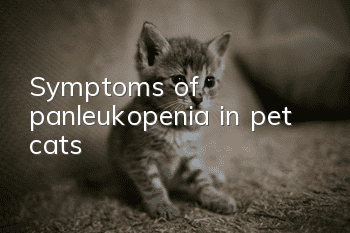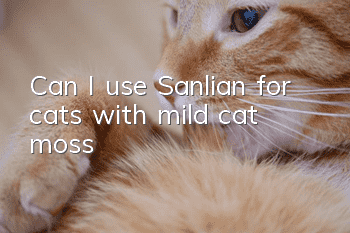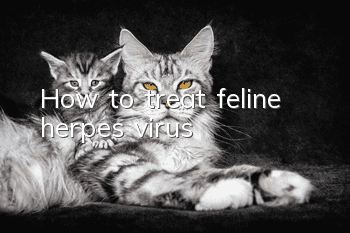Symptoms of panleukopenia in pet cats

There are many diseases that cause cats to have fever and vomiting. If the cat not only has an elevated body temperature, is listless, but also has symptoms of enteritis and diarrhea, and if the cat has not been vaccinated against feline distemper before, then owners should be careful. Probably feline panleukopenia. Feline panleukopenia, also known as feline distemper, is also known as feline parvovirus. This is a disease with a very fatal rate for cats, especially kittens. Many cats with this disease develop diarrhea after having fever. Death occurs suddenly and there is no time for treatment, so this is also a disease that cat owners are extremely afraid of.
Cat panleukopenia will cause a sudden rise in body temperature at the beginning, and this kind of fever is different from ordinary fever. It has a biphasic fever type, that is, the cat's body temperature rises in the early stages of the disease, and 2 to 3 days later The body temperature returns to normal, and then the fever occurs again, forming two fever peaks with the first fever. This is also one of the basis for judging feline plague and general fever and cold. Feline panleukopenia is caused by feline parvovirus, which can be transmitted through direct and indirect contact under natural conditions. Sick cats excrete a large amount of virus through feces, urine, vomitus, etc., contaminating food, utensils and the surrounding environment through the mouth. spread. Cat panleukopenia is related to its own resistance, especially those who are malnourished, frail and after sterilization surgery. Susceptible animals are mainly infected with the disease through the digestive tract and respiratory tract, and pregnant female cats can transmit it vertically to their fetuses through the placenta. When pregnant female cats are infected, they may suffer from miscarriage, stillbirth and other symptoms of reproductive failure. During the onset of the disease, blood tests in the hospital can be found to show that the white blood cells of the sick cats are significantly reduced, which is of great significance for diagnosis.
In late winter and early spring, it is the period of high incidence of feline panleukopenia. During this period, the disease will have a sudden onset, rapid spread, and violent epidemic. We need to take preventive measures in advance.
Of course, the first person who can predict the condition of a cat is the cat’s owner. Only the owner’s careful observation, such as some abnormal behaviors of the cat, the most common one is that the originally lively cat becomes inactive, even though it has a good appetite. Suddenly it doesn't pay attention to the things it usually likes to eat. This can easily be confused with the early stages of estrus, so don’t be careless. Vomiting may also occur, but some cats may only vomit a few times, and it can easily be thought that they are vomiting hair balls carelessly.
If your cat suddenly stops moving and sleeps almost all day long, you should touch its ears frequently. If it continues to have a high fever, test its temperature (the cat’s ear temperature will increase after it falls asleep). (increasing but not always very high), if the body temperature suddenly rises, do not hesitate to take him to a good hospital, and be sure to disinfect the hospital with a good environment, otherwise your cat may not be able to detect feline plague on the spot, but If you bring the germs home and actually attack them a few days later, you're in big trouble.
Don’t panic if your cat has feline distemper. Timely treatment is crucial for panleukopenia in cats. Injecting hyperimmune serum into sick cats has a certain effect. HoweverSince the virus is spread throughout the body, the specific therapeutic effect of immune serum may be limited. The most important treatments are to rehydrate and maintain electrolyte balance, which may save the sick cat. As for other antibiotics, you can also choose penicillin to prevent the invasion of anaerobic bacteria.
Feline parvovirus has very good antigenicity and can maintain high immunity for a long time after infection. Therefore, cats generally become immune to the virus within a certain period of time after the onset of panleukopenia is cured. We can also vaccinate cats to prevent this disease. There are three types of vaccines available: formalin-inactivated tissue vaccine, inactivated cell culture virus vaccine and attenuated live virus vaccine. If the three vaccines are injected according to regulations. It will be very protective.
If the female cat is pregnant, there is no need to use live vaccines. Because the virus in the live vaccine still has a certain degree of toxicity, the virus can be transmitted to the fetus through the placenta, causing the fetus' cerebellum to develop incompletely. Using inactivated vaccines is both safe and ensures a high antibody titer.
If a group of cats is too late to be immunized and some cats become sick, emergency immunization is the best way to prevent the outbreak of feline plague. It should be noted that injecting serum antibodies can only produce immunity in a short period of time. Disease will still occur during the immunization period, so emergency immunization is more effective in immunizing cats and ensuring the safety of other cats.
- Why do cats vomit black liquid?
- When can kittens be vaccinated and dewormed?
- Do British Shorthair cats recognize their owners?
- Will a 2-month-old cat recognize its owner?
- Can kittens with teeth eat cat food?
- What kind of cat is Guapi cat? Do you know?
- Why do Ragdoll cats need to be neutered?
- What are the precautions for keeping cats and dogs together?
- How to breed Chinchilla
- What should the owner do if the cat has a bad temper?



